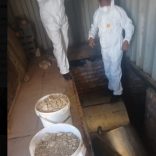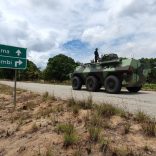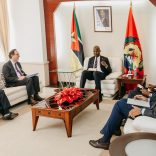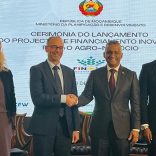Mozambique: Joint force retakes Catupa base from insurgents
How people face crocodiles and other dangers crossing the river in Malei, Zambézia

DW
Recent floods having swept away roads links between Namacurra and Maganja da Costa, the population now has to risk crossings on boats made of straw and bark in waters where crocodile and hippopotamus bathe.
In Malei, in Zambezia province, central Mozambique, young people defy the danger of crocodiles and hippos attack on a daily basis in order to earn some money.
Two years ago, connections between Maganja da Costa and Namacura were severed when floods destroyed the main road and bridge linking the two districts in the Baixo Licungo. They remain unrestored to this day.
The alternative is to cross deep rivers where hippo and crocodile abound in canoes made of straw and bark, a passage to the other shore dozens of young residents risk daily.

Luís Mutaliano is one of them. He has dedicated himself to ferrying people across the river for two years and swears there is no danger. According to this young man, “Crocodiles do not harm people”. People can cross the river “without a problem”.
The ferryman feels “privileged to help people cross the river. Some people do not have money, but we understand and we help. As for the bridge, we do not know how this happened, we are very sad,” he says.
Anyone who needs to cross to the other bank must pay between 10 and 35 meticais, even 50 meticais (about one euro) at high tide.
Demi Izaquiel is another of the young people who have ventured into the crossing business, and claims that “work is going well”, although there are not always many clients. “When there is a lot of traffic, we make 500 to 600 meticais. The money gets spent there at home, on expenses and curry,” he explains.

Inhabitants without option
Francisco Orta, a resident of Maganja da Costa, is one of the regular customers on these straw ferries, but confesses to thinking twice before leaving home. “The crossing of the river is very bad, but there is no other way. We passed that way on Tuesday when I was transferred to Quelimane as a patient, but I was very sick and paid very dearly. We are all suffering financially,” he says.
The crossing between Namacurra and Maganja da Costa through Malei is quite busy because it shortens the distance between the two locations. And, in spite of the risks, it is cheap compared to other options. The only alternative way to reach Maganja da Costa is via Mocuba, about 300 kilometres away.
According to Malei resident Filipe Damas, the situation is “complicated”, and hinges the reconstruction of the road and bridge.

“I would be grateful if the government would do everything possible to re-erect the bridge here, because it would help us a great deal,” he says. “A lot of people arriving here from Maputo cannot reach Maganja da Costa because they don’t have enough money for the crossing. Then they try to sell their goods to cross [to the other side], but that does not help. It’s a setback for us, too,” he explains.
It’s an opinion shared by Cádre Mariano, another Malei resident. “It is very difficult, because to cross, you need money. There are many risks involved in the crossing. People have lost bicycles, even motorcycles,” he says.
Reconstruction of bridge without date in sight
The governor of Zambézia, Abdul Razak, cannot offer much hope regarding the reconstruction of the bridge. Seventy bridges were destroyed in 2015, he says. Although he is aware that the lack of the bridge linking Malei to Maganja da Costa “is holding the population back”, the governor points out that replacing the bridge would cost about four billion meticais, and “the economic situation we find ourselves in is not easy”, he explains.













Leave a Reply
Be the First to Comment!
You must be logged in to post a comment.
You must be logged in to post a comment.